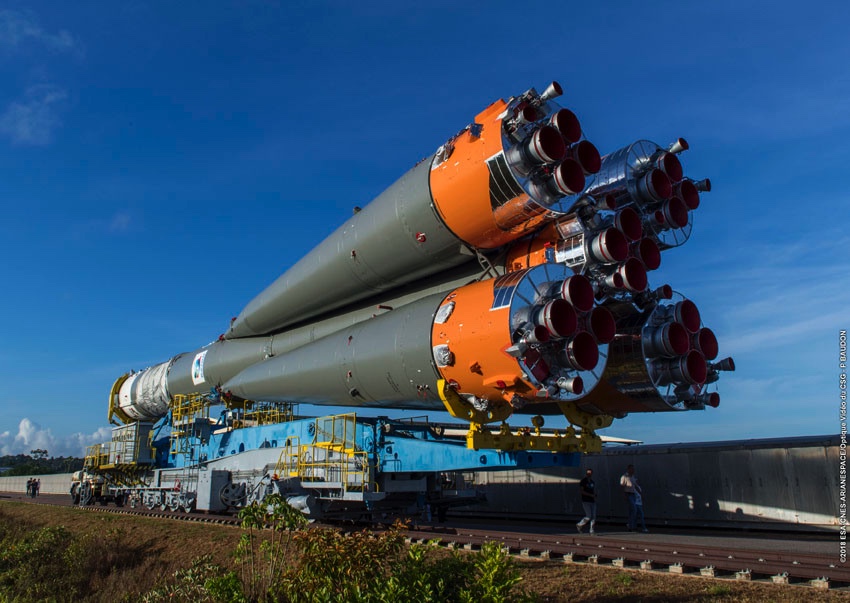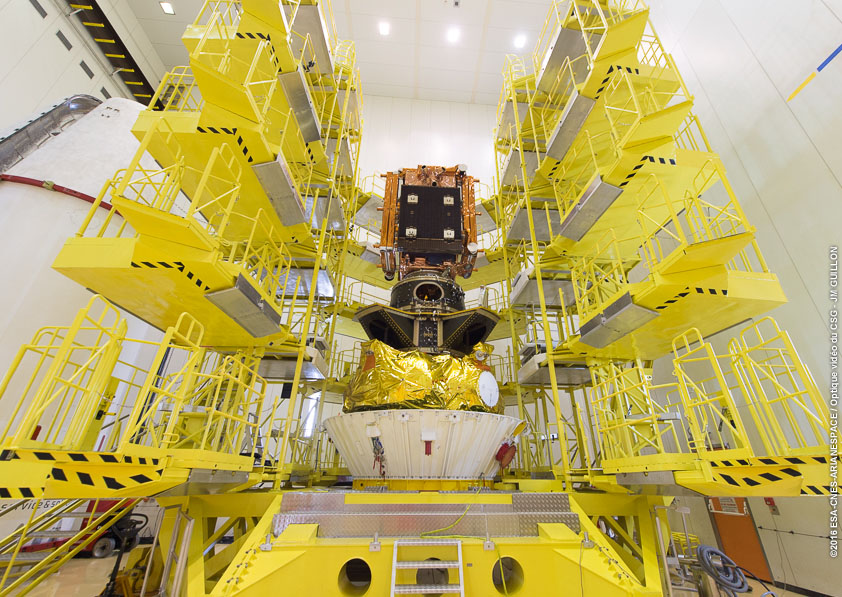
Russian and European teams at the Guiana Space Center in South America plan to detach a UAE spy satellite from its Soyuz launcher to replace the rocket’s Fregat upper stage, forcing a likely delay until early April from the mission’s original launch date of Friday.
Officials detected a problem with the Soyuz rocket’s Fregat upper stage during pre-launch testing this week, according to officials familiar with the launch campaign in French Guiana. The Soyuz booster and Fregat upper stage were being readied to launch the Falcon Eye 2 Earth-imaging satellite for the United Arab Emirates.
Arianespace, the French launch services provider that oversees satellite launches from French Guiana, announced Thursday that the mission was postponed “due to additional checks to be performed on the Fregat upper stage.”
An official familiar with launch operations at the Guiana Space Center said the Fregat upper stage, which is designed to place the Soyuz rocket’s payload into the proper orbit, will be replaced with another upper stage.
Arianespace did not release details about the nature of the problem found on the Fregat upper stage, and the official who confirmed to Spaceflight Now the lengthy delay in the launch also provided no additional information on the technical issue.
Russia’s Tass news agency reported Friday that engineers discovered a malfunction on a circuit board in a heating unit on one of the Fregat upper stage’s small control thrusters. According to Tass, Russian teams concluded the malfunction would not pose a risk during launch, but Emirati officials responsible for the Falcon Eye 2 satellite “decided to play it safe.”
Ground crews at the spaceport in French Guiana transferred the Soyuz rocket to its launch pad earlier this week, then raised it vertical on its launch mount. The Falcon Eye 2 spacecraft and Fregat upper stage — encapsulated inside the Soyuz rocket’s nose fairing — were later attached to the top of the vehicle in preparation for launch Friday night.
The payload and Fregat will now be detached from the rocket and returned to a nearby clean room, where Falcon Eye 2 will be mated to a different upper stage.
UAE officials are eager to get the Falcon Eye 2 satellite safely in orbit after an identical spacecraft named Falcon Eye 1 was destroyed during a launch failure on an Italian-built Vega rocket last July.

The Vega launcher, built by Avio of Italy and operated by Arianespace, fell back to Earth minutes after liftoff from French Guiana, ending a run of 14 straight successful missions for the light-class satellite launcher since its debut in 2012. Engineers investigating the failure concluded super-hot gas from burning solid propellant impinged on the structure of the Vega’s second stage, causing the vehicle to break apart a little more than two minutes after liftoff.
The Falcon Eye 1 mission was insured for 369 million euros, or $407 million, including the value of the satellite and the launch, according to Space News.
Officials from the UAE government, which owns the billion-dollar Falcon Eye program, decided after last year’s failure to swap the launch of the identical Falcon Eye 2 satellite in the Arianespace launch schedule from a Vega rocket to a Soyuz booster.
Airbus Defense and Space built the Falcon Eye satellites, and Thales Alenia Space provided the high-resolution optical imaging payloads for both spacecraft.

The Falcon Eye 2 satellite will provide high-resolution surveillance imagery to the UAE military. The twin spacecraft were built on the design of the French Pleiades Earth-imaging satellites launched in 2011 and 2012, and reportedly have a resolution of about 2.3 feet, or 70 centimeters, in their highest-resolution imaging mode.
Preparations for the first Vega launch since last year’s failure continue at the Guiana Space Center. Liftoff of the Vega’s return-to-flight mission is scheduled for March 23 from French Guiana on a rideshare flight carrying several dozen small satellites into orbit.
The one-month delay in Falcon Eye 2’s launch will also push back the following Soyuz launch from French Guiana, which was previously set for April 10. That mission will loft the French military’s CSO 2 optical spy satellite some time later in April or in May.
Arianespace has up to 22 missions planned in 2020, which would exceed the company’s previous record of 12 launches in a single year.
The launches planned in 2020 include flights from French Guiana by Ariane 5, Soyuz and Vega rockets. Europe’s two next-generation launchers — the Vega C and Ariane 6 — could also debut later this year from the Guiana Space Center.
Up to eight Soyuz launches from the Baikonur Cosmodrome in Kazakhstan and the Vostochny Cosmodrome in Russia’s Far East are also on Arianespace’s 2020 launch manifest.
Arianespace has accomplished three missions so far this year: Two Ariane 5 launches and one Soyuz flight.
Email the author.
Follow Stephen Clark on Twitter: @StephenClark1.



